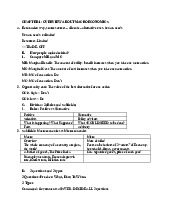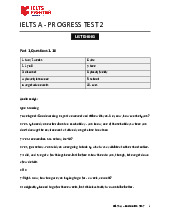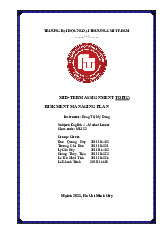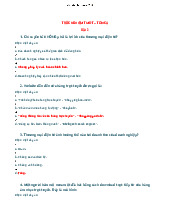


Preview text:
lOMoAR cPSD| 58562220
TRƯỜNG ĐẠI HỌC NGOẠI THƯƠNG
ĐỀ THI KẾT THÚC HỌC PHẦN KHOA TACN ESP111 – TACN1 BỘ MÔN TACS
__________________________________
_________________________
Giai đoạn 1 - Học kỳ I Năm học: 2022-2023
COURSE: BUSINESS STUDIES
Hệ: Chính quy CLC Khoá: K60CLC
Ngày thi: 27/12/2022 Ca thi: 9.30
Thời gian làm bài: 75 phút(không kể thời gian phát đề)
Họ và tên sinh viên:………………………………………..……………….. MSV:…………………………
Lớp tín chỉ: ESP111(GD1+2-HK1-2223)._________ Giáo viên coi thi 1 Giáo viên coi thi 2
Giáo viên chấm thi 1
Giáo viên chấm thi 2
Điểm bài thi (bằng số)
Điểm bài thi (bằng chữ)
Attention: Students are NOT allowed to use any study materials and dictionaries in this test. Mobile phones
and other electronic devices are strictly PROHIBITED. Write your answers on the space provided.
PART 1 – READING COMPREHENSION (20 points)
Read the article below and decide if each statement from 1-5 is TRUE, FALSE or NOT GIVEN
Manufacturing companies require three basic functions: finance, production or operations, and
marketing. Finance raises the capital to buy the equipment to start the business, production or
operations makes the product, and marketing sells and distributes it. Operations management is also
of crucial importance to service companies.
The objectives of the production department are usually to produce a specific product, on schedule, at
minimum cost. But there may be other criteria, such as concentrating on quality and product reliability,
producing the maximum possible volume of output, fully utilizing the plant or the work force, reducing
lead time, generating the maximum return on assets, or ensuring flexibility for product or volume
changes. Some of these objectives are clearly incompatible, and most companies have to choose
between price, quality, and flexibility. There is an elementary trade-off between low cost and quality,
and another between low cost and the flexibility to customize products or to deliver in a very short lead time.
Production and operations management obviously involves production plants and factories or service
branches, and the equipment in them, parts (raw materials or supplies), processes (the steps by which
production or services are carried out), and planning and control systems (the procedures used by
management to operate and monitor the system). But it also involves people - the personnel or human
resources, who will always be necessary in production and operations, despite increasing automation.
People are particularly important in organizations offering a service rather than making a product.
Such organizations exist to serve the customer, but it can also be argued that they have to serve their
workforce, because workers will often treat the public the same way that management treats them, so
staff training and motivation are clearly important.
Manufacturing companies all have to decide how much research and development (R&D) to do.
Should they do fundamental or applied research themselves, or use research institutes, universities,
and independent research laboratories, or simply license product or service designs from other 1 lOMoAR cPSD| 58562220
organisations as necessary? Companies are faced with a 'make or buy' decision for every item, process or service.
Decisions about what products to make or what services to offer have to take into account a company's
operational capability, and labour, capital and equipment requirements. Introducing new products
obviously requires accurate sales forecasting. If it is necessary to construct a new plant or facility,
decisions have to be made concerning its location, its size or capacity, the floor layout, the hiring of
staff, the purchase of equipment, the necessary level of inventory of parts and finished products, and so on. 1.
Production or operations management is important to all businesses. ________ 2.
Production departments usually concentrate on quality, quantity, and flexibility. ________ 3.
Workers who are treated well will probably be more productive. ________ 4.
Large companies are generally obliged to do their own research and development.
________ 5. Decision-making concerning new products or the building of new production
________ facilities follows sales forecasting.
PART 2 – WRITING (80 points)
Writing 1: Fill in the blank for each sentence from 6 to 10 with suitable words or phrases. (20 points)
6. ________________________________ means that interviewers are unconsciously biased
towards individuals who resemble the stereotype or prototype they have in their heads about what
a competent person or a good candidate for a jog should look like. (02 words)
7. In organization, _________________________________ conflicts often arise when people from
different departments are over concerned about the success of their own department rather than
the performance of the whole organization. (01 word)
8. With fiscal policy,_________________________ and public spending are two instruments
employed by the government to boost the economy. (01 word)
9. Setting a high price for a new product to make maximum revenue before competing products
appear on the market is _____________________________________. (02 words)
10. An economy slides into _____________________________ when it experiences a downturn in
two executive quarters. (01 word)
Writing 2: Answer the following questions. (20 points)
11. Why do some companies introduce multiple branding strategies?
________________________________________________________________________________
________________________________________________________________________________
________________________________________________________________________________
________________________________________________________________________________
12. What do you think the objectives of a production department usually are?
________________________________________________________________________________
________________________________________________________________________________
________________________________________________________________________________
________________________________________________________________________________ lOMoAR cPSD| 58562220 2
13. Compare pyramid structure and functional structure.
________________________________________________________________________________
________________________________________________________________________________
________________________________________________________________________________
________________________________________________________________________________
14. What are the possible consequences of excess capacity?
________________________________________________________________________________
________________________________________________________________________________
________________________________________________________________________________
________________________________________________________________________________
Writing 3: Write an essay of at least 250 words to answer these questions. (40 points)
Why is it not usually possible to organize a large organization in a single hierarchy? Give some
examples of standard conflicts of interest between departments with different objectives. Are there
any other ways of organizing companies that might solve these problems?
--------------------------------------Hết--------------------------------------
Ghi chú : Đề thi gồm có 2 phần - 15 câu. DUYỆT ĐỀ THI
- Thí sinh không được sử dụng tài liệu.
- Cán bộ coi thi không giải thích gì thêm.
Write your answer for Writing 3 here
_______________________________________________________________________ _______
________________________________________________________________________________
________________________________________________________________________________
________________________________________________________________________________
________________________________________________________________________________
________________________________________________________________________________
________________________________________________________________________________
________________________________________________________________________________
________________________________________________________________________________
________________________________________________________________________________
________________________________________________________________________________
________________________________________________________________________________
________________________________________________________________________________
________________________________________________________________________________
________________________________________________________________________________




